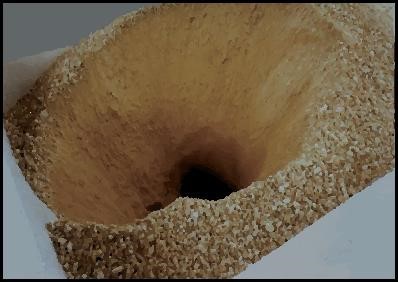Ratholes and flow challenges

Common and costly bulk material flow challenges include arching of product to inhibit free flow and the clogging condition known as ratholing. These wasteful, energy-consuming and sometimes hazardous events occur when handling and storing a wide range of cohesive materials, such as flour and food and beverage ingredients and materials on silos, hoppers and transfer chutes of conveyor systems.
Ratholing occurs when cohesive bulk materials are stored and conveyed in vessels with a funnel flow discharge pattern. When a stable rathole develops, the bulk material remaining in the vessel is stagnant and will not discharge. This stagnant inventory of bulk material can spoil, cause cross batch contamination, spontaneously combust and limit storage capacity.
Similar problems occur with arching, which occurs when an arch-shaped or bridge obstruction forms above the hopper outlet and stops flow. It can be an interlocking arch, where large particles mechanically interlock to form an obstruction, or a cohesive arch. A cohesive arch occurs when particles bond together due to effects of moisture, fines concentration, particle shape, temperature and other factors.

Australian engineering is answering many of these challenges using a flow-promoting plastic liner material UHMWPE (ultra high molecular weight polyethylene) Green Wearex material formulated and shaped to increase the throughput and capacity of hoppers and silos by curtailing the ‘hang-up’ of materials and eliminating dead spots in material flow.
“In many situations, the condition of ratholing and arching occurs because the wall surfaces of the vessel are not steep or smooth enough for materials to flow,” said Pat Flood, NSW manager of the national and international engineered plastics specialist Cut To Size Plastics.
Cut To Size custom-engineers solutions to such issues using Green Wearex, which is a regenerated material specifically formulated to promote material flow in situations as diverse as mines, ports and hygiene-intensive food, beverage and agricultural processing and packaging facilities.
“Green Wearex achieves mass flows while eliminating the ratholing and arching problems that can hamper flow rates and increase downtime in unlined materials handling technology,” said Flood. The improvements reduce the need for energy-consuming air cannons or vibratory equipment to dislodge hang-up material, reducing costs and enhancing profitability.
Abrasion and corrosion resistance
Green Wearex’s very high molecular weight delivers a combination of low coefficient of friction together with high abrasion and corrosion resistance. This permits reliable handling of a wide range of cohesive materials with ‘funnel flow’ characteristics in which flow issues arise because they are affected greatly by variables such as moisture content, temperature and storage design.
These factors can result in a material bulk which has a tendency to stick to conventional lining materials — a difficulty which needs to be overcome at the material wall interface, so the material can flow down or along the hopper or chute wall.
“Often a solution to a funnel flow problem is to convert the discharge pattern to mass flow, facilitating uniform dwell time, minimising stagnant areas and keeping all of the material moving. To ensure this mass flow, the bunker or bin walls must be sufficiently steep and have a sufficiently low coefficient of friction to allow the material to flow along them.
Green Wearex achieves this mass flow with a low co-efficient of static and dynamic friction, while its wear resistance ensures a long life, even against abrasive materials.
Cut To Size Plastics manufactures components for applications across Australasia and the Asia-Pacific from its head office in Sydney, where facilities include CNC machining facilities coupled with GibbsCAM and Solidworks software.
Irish drinks manufacturer takes its supply chain to the next level
A stainless steel vertical conveyor system has been incorporated into the final packaging process...
Voice technology used to transform cold storage operations
Dematic has implemented its Voice solution with gamified workflow features at two Australian...
Rock lobster exporter improves supply chain efficiency
Transport technology provider Microlise partners with rock lobster exporter in Western Australia...











